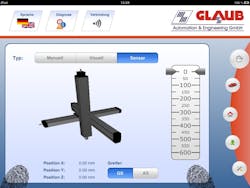Glaub Automation & Engineering is one of the first system integrators to implement gesture commands for control in manufacturing. In a building used by Glaub Salzgitter, Germany, Matthias Fleischer, software developer, is standing in front of a three-axis system with a gripper arm. The software developer has a tablet PC in his hand and its display shows a schematic depiction of the axes. Fleischer places his thumbs on two marked spots and tilts the tablet PC. As if by magic, the system of axes and the gripper arm move. The more the mobile device is tilted, the faster the movement. As soon as he removes either of his thumbs, the system stops.
“Smartphones and tablet PCs are our companions in the consumer digital world, providing access to and interaction with consumer services like electronic plane ticketing, bank transfers or navigation systems,” explains Dr. Ralf Koeppe, vice president electric drives and controls at Bosch Rexroth. “Millions of apps for all kinds of situations can be used with the simple swipe of a finger, drastically improving the user experience of today’s communication and IT devices. Now the door is open for the world of machinery. With the software technology, Open Core Engineering, and its interface technology, Open Core Interface, Bosch Rexroth allows machinery manufacturers to use smart devices for commissioning, diagnosis and operation.”
At first, smartphones and tablet PCs were considered to be toys for geeks. But they have revolutionized everyday life. Billions of people use them to retrieve information from random locations, download small application programs, shop online and increasingly control their household technology. Instead of a computer mouse and keyboard, two fingers are enough to flip through the pages, zoom or confirm. This simple operation is now in high demand with machine operators. And their training efforts can be reduced considerably (Figure 1).
Figure 1: Instead of a computer mouse and keyboard, two fingers are enough to flip through the pages, zoom or confirm. This simple operation is now in high demand with machine operators, greatly reducing training efforts.
“The interface technology provides easy and powerful access to the world of IT devices, the ease of use and the mobility of smartphones and tablet PCs,” says Koeppe. “Machine manufacturers program their operating and diagnostic surfaces as apps in a programming environment on the operating systems of the smart devices. Open Core Interface ensures that machine control understands and carries out the orders of these application programs directly. No programming of the controls is necessary. This is a great innovation considering that the programming and control interface typical in today's market only understand programming languages of the world of automation.”
Apps for iOS and Android
The first apps for commissioning and operating machines show how smart devices are facilitating the approach to machine functions. For example, Glaub Automation uses the acceleration sensors of tablet PCs to program axle movements. Until now, when a commissioning engineer wanted to move an axle, he had to enter data: the distance, the terminal position, the acceleration, the maximum speed and the braking before the terminal position.
Also read: Operator Interfaces Go Mobile: Why and how to implement them for your systems
Figure 2: To control this triaxial system, Glaub uses a control and diagnostics app for iOS and Android in order to obtain initial experience and get to know more about how the technology functions.
In the app developed by Glaub Automation, the operator sets his two thumbs onto two stylized finger prints on the display of the tablet PCs. Then he tilts the device to the side and the axle moves. The stronger the tilt, the stronger the drive accelerates. As soon as a thumb releases the finger prints, the axle stops. In other apps, the commissioning engineer moves the controller on the display in order to determine the acceleration.
To control its triaxial system, Glaub Automation uses a control and diagnostics app for iOS and Android in order to obtain initial experience and get to know more about how the technology functions (Figure 2). With its Open Core Engineering concept, Bosch Rexroth is setting something significant in motion. It’s assuming a leadership role when merging the world of manufacturing with the IT infrastructure used in offices. It’s unleashing all the advantages we know today in the control of mobile devices.
Direct access to the control functions and to the variables in the PLC is implemented by Glaub with the help of three high-level languages: C++, Objective-C and Java. “Now I can shift complex logic away from the PLC,” explains Glaub’s Fleischer. “This is a great help, since some programming in high-level languages is far simpler than using the ladder diagram, instruction list or structured text.” When developing the app, Glaub Automation placed great emphasis on a simple and intuitive user interface. A toolbar at the edge of the screen lets users access the most frequently used main menus. These include manual operation, automatic operation, starting page, moving to the home position and adjustments.
Various submenus can be selected from each main menu. In manual operation, for instance, users can select from a number of different modes in order to move the axes to a defined position. In addition to machine movements controlled by the accelerometers integrated into the smart device, the user can also control the system of axes with gestures executed on the touchscreen. There is also a diagnosis button in the header for the app.
The operator can use this button to obtain information on the states of the axes and the controls; the operator can have individual parameters for the drives shown or can read out the log file.
“Implementing these functions was amazingly simple,” explains Fleischer. “After configuring and programming the PLC with Rexroth’s IndraWorks engineering tool, we only had to integrate the header and library files provided.” Thus developers, after just a few hours of work, were able to start programming the functions in the high-level languages Objective-C or Java.
Intuitive operation
Since users are already familiar with dealing with smart devices in their personal lives, they have instant rapport with the new control concepts using apps. We are now in a position to realize very simple machine control concepts. That will save training costs for the machine’s owner. In addition, we can largely do away with language-based components in operator prompts, and that is interesting for the industrial environment in a worldwide production network.
As a system integrator for Bosch Rexroth, Glaub Automation has already implemented a successful Open Core Engineering application for a customer. The company developed a Windows application for a manufacturer of roller and axle dynamometers for vehicles. Here Rexroth supplied the control and drive technology, while Glaub Automation developed the user interface, based on the C++ language. “It accesses the controls directly via the Open Core Interface,” explains Rexroth’s Koeppe.
“Thus the technician can generate even complex motion patterns and then transfer them to individual axes. During testing, variables like torque, joint- or Cartesian velocity and position can be varied and visualized for up to three axles, with two wheels each. In concrete terms, up to six servo axles can be controlled separately. It will even be possible to implement this user interface as an app on a smart device, without having to modify the current program sequence for the PLC.”
An exciting future
The diagnosis of machinery is also becoming considerably faster and simpler through the use of smart devices. “Maintenance technicians can, with the respective authorizations, dial into different machines in sequence using wireless technology,” says Rexroth’s Koeppe. “They retrieve all diagnostic data with one user interface from any location. Navigation occurs through the swipe of a finger. In the case of an error, they can even change parameters and then fix a machine stop.”
Figure 3: Machinery manufacturers can now, for example, also fully integrate smart devices into automation and take advantage of the operational interface capabilities.
In 2013, Open Core Engineering received the Deutsche Messe 2013 Hermes Award technology prize. Open Core Engineering connects the previously separate PLC and IT worlds by offering an integrated solution consisting of open standards, software tools, function toolkits and the Open Core Interface. To achieve this, Rexroth has opened the control core to provide expanded access. “With a variety of high-level languages and operating systems, machinery manufacturers can create independent, individual functions, which run parallel to the firmware directly on the control unit or on external devices,” explains Koeppe. With this capability, machinery manufacturers can now, for example, also fully integrate smart devices into automation and take advantage of the operational interface capabilities.
“I see major opportunities in manufacturing automation using Open Core Engineering,” predicts Glaub. “It lets us create user interfaces for machines that don’t scare operators away, but instead are fun to use (Figure 3). This means greater employee motivation. Seen against the background provided by Open Core Engineering, we are looking forward to an exciting future. The topic of connected industry came at just the right time, since it offers us a huge playing field and lots of potential that we’re looking forward to using.”
About the Author
Niko Glaub
Glaub Automation

Leaders relevant to this article:




